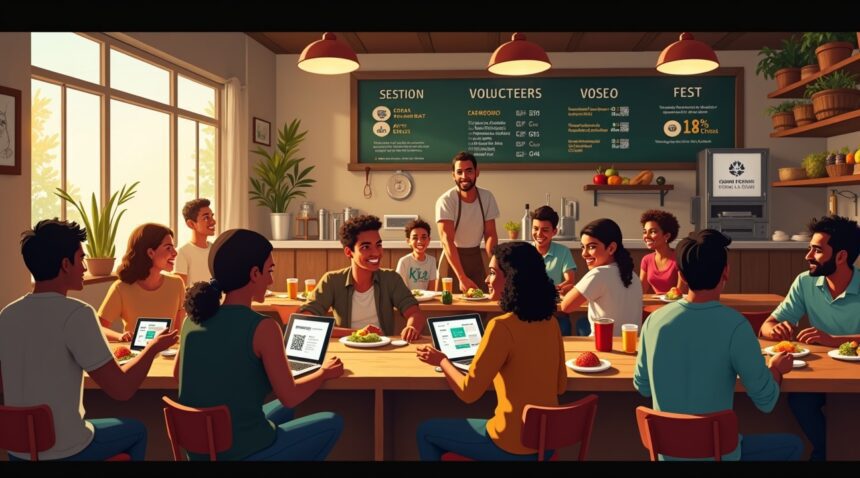This revolutionary restaurant concept operates entirely without fixed menu prices, allowing customers to pay based on their financial ability – whether that’s full price, partial payment, or nothing at all.
The model fundamentally challenges traditional dining economics by relying on customer generosity and community spirit rather than predetermined profit margins, creating a natural wealth redistribution system within the restaurant itself.
Key Takeaways
- Community-driven sustainability relies on wealthy patrons paying above typical prices to support those experiencing financial hardship, creating a delicate balance that requires strong local support and strategic partnerships.
- Technology enables seamless implementation through contactless payments, QR code menus, and digital platforms that allow discreet variable contributions while providing transparency about community impact.
- Alternative revenue streams are essential, including catering services, fundraising events, volunteer programs, and partnerships with local organizations to supplement unpredictable daily customer payments.
- Success depends on strategic location and demographics, with mixed-income neighborhoods providing the optimal balance of paying customers and those in need, along with transparent communication about the restaurant’s mission.
- Customer loyalty transcends traditional metrics as emotional investment in the community mission creates advocates who bring others and contribute beyond typical meal costs, proving that social responsibility can coexist with business sustainability.
How This Restaurant Model Defies Traditional Business Logic and Creates Community Impact
This revolutionary restaurant concept flips conventional business practices on their head by operating entirely without fixed menu prices. Customers walk in, order whatever they’d like, and pay based on their financial ability – whether that’s full price, partial payment, or nothing at all. The model fundamentally challenges the transactional nature of traditional dining establishments.
Traditional restaurants rely on calculated profit margins, predetermined pricing structures, and predictable revenue streams. They set menu prices based on food costs, labor expenses, overhead, and desired profit margins. This pay-what-you-can approach abandons those financial safeguards entirely, placing complete trust in customer generosity and community spirit.
The restaurant’s success hinges on a delicate balance between those who can afford to pay full price or more and those experiencing financial hardship. Wealthy patrons often contribute significantly above typical menu prices, while others pay what they’re able to manage. This creates a natural wealth redistribution system within the dining room itself.
Customer generosity becomes the cornerstone of operations rather than traditional profit maximization strategies. The model attracts socially conscious diners who appreciate the opportunity to support both the business and their fellow community members. Many customers report feeling more connected to their meals and the establishment because they actively participate in keeping the doors open.
Community-Driven Success Factors
Several key elements make this unconventional business model viable:
- Strong community support from local residents who believe in the restaurant’s mission
- Strategic partnerships with local farms and suppliers who provide ingredients at reduced costs
- Volunteer staff members who donate their time to reduce labor expenses
- Media attention and word-of-mouth marketing that attracts curious diners and philanthropic customers
- Careful location selection in areas with diverse economic demographics
- Transparent communication about the restaurant’s financial needs and community impact
The social responsibility aspect draws customers who might never visit a traditional restaurant multiple times per month. These establishments often become community gathering spaces where people from different economic backgrounds share meals and conversations. The model breaks down social barriers that typically exist in commercial dining settings.
Revenue management requires constant adaptation and creative problem-solving. Restaurant owners must maintain detailed records of daily contributions while monitoring food costs and operational expenses. Some days bring in more revenue than traditional restaurants, while others require drawing from reserve funds or community donations to cover basic costs.
The psychological impact on both customers and staff differs dramatically from conventional restaurants. Diners report feeling less stress about ordering decisions because they’re not constrained by budget limitations. Staff members often develop stronger relationships with regular customers since the transactional barrier has been removed.
Community impact extends beyond the restaurant walls as the model inspires similar initiatives in other sectors. Local businesses sometimes adopt sliding-scale pricing for services, while community organizations use the restaurant as a model for their own programming. The ripple effect creates a more inclusive economic ecosystem throughout the surrounding area.
Marketing strategies focus on storytelling and community building rather than promotional pricing or competitive advantages. The restaurant’s unique concept generates organic publicity through social media sharing and local news coverage. Many customers become unofficial ambassadors, bringing friends and family members to experience the model firsthand.
Financial sustainability requires diverse revenue sources beyond customer payments. Grant funding from foundations, donations from local businesses, and fundraising events help supplement daily operations. Some restaurants partner with entertainment venues or host special events to generate additional income streams.
The model challenges customers to examine their own relationship with money and community responsibility. Regular patrons often develop a deeper appreciation for the true cost of restaurant operations and the challenges facing food-insecure individuals. This awareness frequently leads to increased charitable giving and community involvement beyond the restaurant setting.
Success metrics shift from traditional profit-and-loss statements to community impact measurements, customer satisfaction surveys, and social media engagement rates. The restaurant’s value extends far beyond financial returns, creating lasting positive change in local communities while proving that alternative business models can thrive.
Why Restaurants Are Struggling More Than Ever to Stay Profitable
Restaurant prices are climbing at an alarming rate, with costs rising 3.9% year-over-year as of August 2025. This surge significantly outpaces grocery prices, which have increased by only 2.7% during the same period. The disparity creates a challenging environment where diners increasingly question the value proposition of eating out versus cooking at home.
Labor costs represent the most substantial burden facing restaurant operators today. These expenses have skyrocketed by over 35% since 2019, fundamentally altering the economic landscape for food service establishments. Minimum wage increases, enhanced benefits packages, and intense competition for skilled workers have all contributed to this dramatic escalation. Many restaurants find themselves caught between the need to attract quality staff and the pressure to maintain affordable menu prices.
Customer acquisition costs add another layer of complexity to restaurant operations. Digital marketing channels, once considered cost-effective solutions, now demand substantial investments to generate meaningful returns. Social media advertising, delivery platform fees, and online reputation management tools consume increasingly larger portions of operational budgets. Gaming studios and entertainment companies often have more predictable customer acquisition costs compared to restaurants, which must constantly adapt to changing consumer preferences.
Alternative Strategies for the Pay-What-You-Can Model
The “pay what you can” restaurant model faces unique challenges in this inflationary environment. Unlike traditional establishments that simply raise menu prices to offset rising costs, these innovative restaurants must develop creative strategies to maintain profitability. I’ve observed several key approaches that successful pay-what-you-can establishments employ:
- Building strong community partnerships to supplement revenue through donations and sponsorships
- Implementing efficient operations that minimize waste and maximize ingredient utilization
- Developing robust volunteer programs to offset some labor costs while maintaining service quality
- Creating diverse revenue streams through catering, cooking classes, or retail product sales
- Focusing intensively on customer retention rather than expensive acquisition campaigns
Traditional restaurants often respond to operational pressure by implementing automatic service charges or increasing portion prices. However, pay-what-you-can establishments must rely heavily on customer loyalty and retention strategies. These restaurants invest significant effort in creating meaningful connections with their communities, understanding that emotional investment often translates to sustainable financial support.
The success of this model depends largely on effective cost management and operational efficiency. I’ve noticed that successful pay-what-you-can restaurants often operate with leaner staffing models, simplified menus that reduce food waste, and strong relationships with local suppliers who may offer discounted ingredients in exchange for community goodwill.
Restaurant inflation continues to pressure all food service operations, but pay-what-you-can establishments face the additional challenge of maintaining accessibility while covering rising operational expenses. Flying cars may seem like science fiction, but the financial pressures facing restaurants today are very real and immediate.
Customer acquisition costs in the restaurant industry now require more strategic thinking than ever before. While Rush Hour 4 generates excitement through traditional marketing channels, restaurants must carefully balance their marketing investments with actual revenue potential. Pay-what-you-can restaurants often find that word-of-mouth marketing and community engagement provide better returns than expensive digital advertising campaigns.
The economic pressures facing restaurants today reflect broader inflation trends affecting multiple industries. Even technology companies developing liquid robots or entertainment franchises like Valorant franchising must adapt their business models to accommodate changing economic conditions. Similarly, Star Lord spin-off movies require careful budget management to ensure profitability.
Operational expenses continue mounting pressure on restaurant margins across all segments. Pay-what-you-can restaurants must master the delicate balance between maintaining their core mission of accessibility and ensuring long-term financial sustainability in an increasingly challenging economic environment.
Building Customer Loyalty When You Can’t Control Revenue
Restaurants face unique challenges in customer retention, averaging just 55% compared to other industries. This statistic becomes even more critical for establishments operating on a “pay what you can” model, where traditional revenue streams don’t apply. I’ve observed that building strong customer relationships becomes the cornerstone of sustainability when pricing flexibility meets unpredictable income.
Creating Loyalty Beyond Traditional Rewards
Customer loyalty programs influence 80% of consumers, but pay-what-you-can restaurants must think creatively. These establishments can’t rely on conventional point systems or discounts. Instead, I recommend focusing on these relationship-building strategies:
- Personal recognition systems that remember customers’ names and preferences
- Community appreciation events that celebrate regular patrons
- Volunteer opportunities that let customers contribute time instead of money
- Social media features highlighting customer stories and contributions
- Behind-the-scenes experiences like cooking classes or kitchen tours
The unpredictable revenue model actually creates opportunities for deeper connections. Customers who experience genuine care and community involvement develop emotional attachments that transcend monetary transactions. I’ve seen successful establishments where patrons become advocates, bringing friends and family members regularly.
Strong customer relationships prove essential when revenue fluctuates daily. Regular customers provide stability through consistent visits, even if individual payments vary. They also serve as brand ambassadors, sharing positive experiences that attract new diners. Creating engaging experiences becomes more important than profit margins.
Personalized approaches work exceptionally well in this model. Staff members who remember dietary restrictions, favorite dishes, or family situations create meaningful connections. These relationships encourage customers to return and contribute what they can, understanding their support directly impacts the restaurant’s mission.
The key lies in shifting focus from transaction-based interactions to relationship-centered service. When customers feel valued as individuals rather than revenue sources, they develop genuine loyalty. This emotional investment often translates into consistent patronage and word-of-mouth marketing that money can’t buy.
Successful pay-what-you-can restaurants understand that customer retention depends on community building rather than traditional business metrics. They create spaces where people feel welcomed regardless of their financial situation, fostering an environment where loyalty grows naturally through shared values and mutual respect.
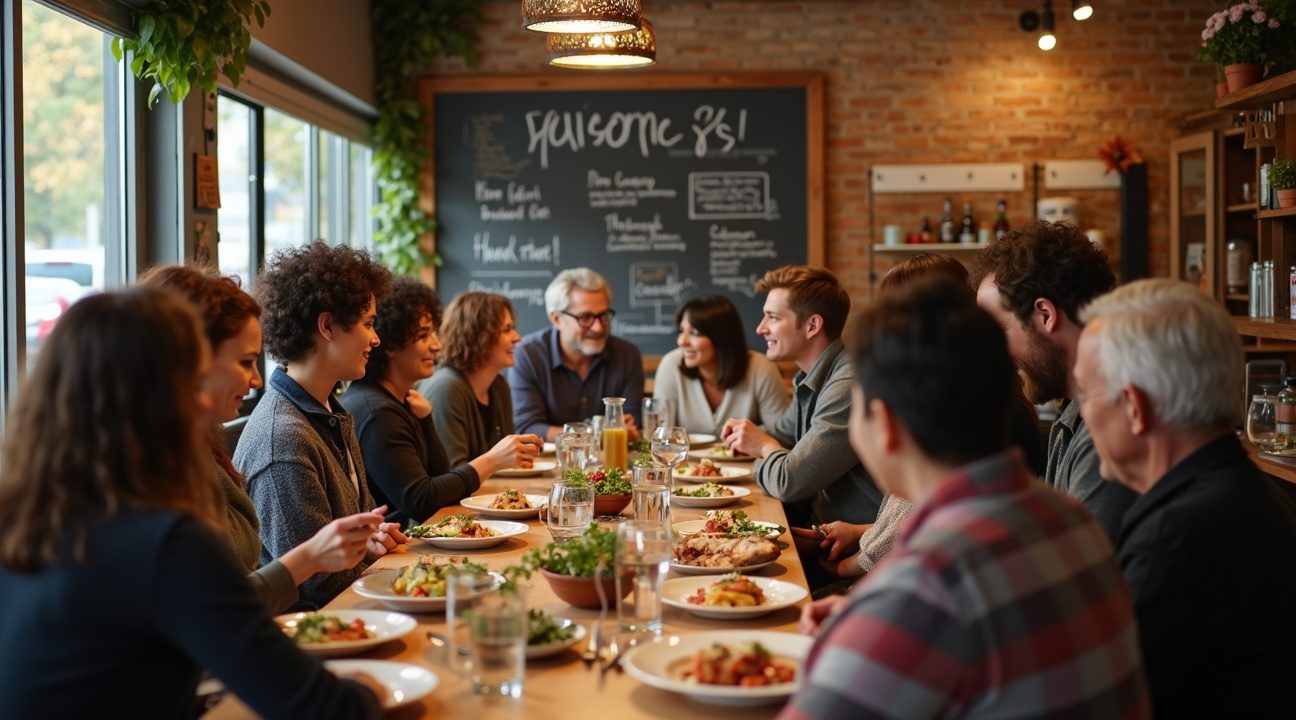
How Modern Payment Technology Makes Pay-What-You-Can Possible
The shift toward digital payment methods has revolutionized how restaurants operate, creating new opportunities for innovative business models like pay-what-you-can establishments. Modern technology doesn’t just enhance convenience; it fundamentally transforms how customers can contribute to restaurants that prioritize community service over profit margins.
The Rise of Contactless and Mobile Payment Preferences
Consumers have embraced contactless and mobile payments with remarkable enthusiasm, with 79% now favoring these methods over traditional cash transactions. This preference creates an ideal foundation for restaurants operating on flexible payment models. Unlike traditional establishments where fixed prices create barriers, pay-what-you-can restaurants benefit significantly from the seamless nature of digital transactions.
Mobile payment apps allow customers to input any amount they choose, making voluntary contributions feel natural rather than awkward. Someone experiencing financial hardship can discreetly pay a small amount or nothing at all, while others who want to support the mission can easily contribute more than a typical meal would cost. Digital payment solutions eliminate the social pressure that might come with counting out exact change or explaining payment limitations to staff.
QR Code Menus and Digital Solutions Transform the Experience
QR code menus have become standard in restaurants, offering much more than just contactless menu viewing. For pay-what-you-can establishments, these digital platforms can display suggested donation amounts alongside menu items, providing guidance while maintaining flexibility. Customers can scan a code, select their meal, and choose their contribution level through the same interface.
The technology also supports transparency, which builds trust in community-focused restaurants. Digital platforms can display real-time information about how many meals the restaurant has served, community impact stories, or operational costs. This information helps customers make informed decisions about their contributions. Much like how Netflix decides to expand its services based on user data, restaurants can use payment analytics to understand community needs and adjust their offerings accordingly.
Payment processing systems designed for variable amounts handle everything from zero-dollar transactions to generous donations seamlessly. Some platforms even allow customers to add tips for kitchen staff or contribute to specific funds, such as:
- Meal programs for local schools
- Homeless shelter meals
- Emergency food assistance
These features turn each transaction into an opportunity for deeper community engagement.
Digital receipts provide another advantage, automatically generating documentation for tax-deductible donations when applicable. Customers who contribute above suggested amounts can receive proper receipts for their charitable giving, encouraging higher contributions from those who can afford them.
The integration of modern payment technology also reduces administrative burden for restaurant operators. Automated systems track all transactions, generate reports for financial planning, and provide data insights that help optimize operations. Staff can focus on food preparation and customer service rather than handling complex payment calculations or cash management.
Payment apps increasingly offer features like recurring donations, allowing regular customers to set up automatic monthly contributions. This creates a more stable revenue stream for pay-what-you-can restaurants while giving supporters a convenient way to provide ongoing assistance.
The technology even enables creative payment options, such as allowing customers to:
- “Pay it forward” to cover meals for future visitors
- Contribute to special holiday meal funds
- Purchase meal vouchers for people experiencing homelessness
These systems create a bridge between community members who want to help and those who need support.
Digital payment systems also provide valuable data about customer preferences and peak dining times, helping restaurants optimize their operations and food purchasing. Understanding when demand is highest allows better staffing decisions and reduces food waste, ultimately supporting the restaurant’s mission to serve as many people as possible efficiently.
Modern payment technology transforms pay-what-you-can restaurants from challenging business ventures into viable community resources. The convenience, flexibility, and transparency these systems provide benefit both customers and restaurant operators, making it easier than ever to create dining experiences that prioritize human dignity over profit margins.
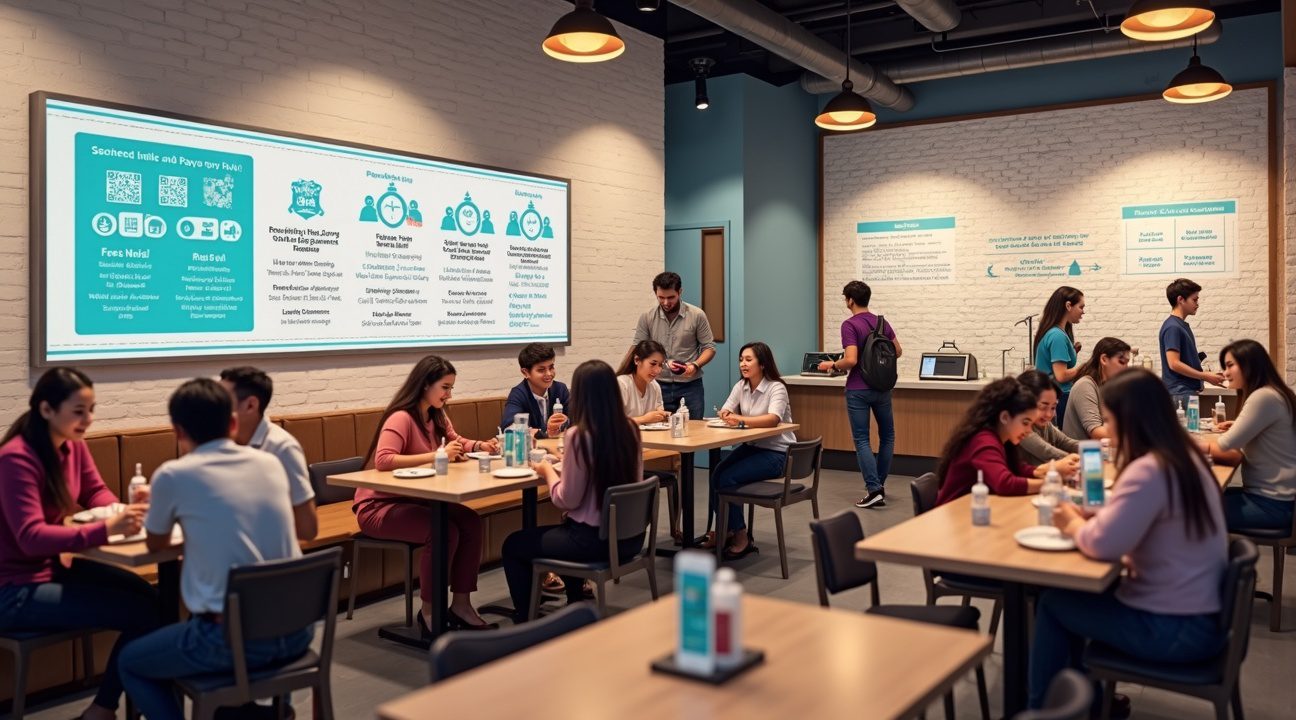
The Restaurant Industry’s Growing Appetite for Innovation
The restaurant industry stands on the brink of significant expansion, with analysts projecting 4% growth in 2025. This upward trajectory reflects a sector that’s actively embracing digital transformation and prioritizing enhanced customer experiences. Quick-service restaurants continue demonstrating strong margins even during economic uncertainty, proving that innovative approaches can thrive regardless of market conditions.
Digital Revolution Driving Customer Engagement
Digital transformation has become the cornerstone of modern restaurant operations. Establishments are leveraging technology to create more personalized dining experiences, streamline operations, and build stronger community connections. The integration of digital platforms allows restaurants to reach broader audiences while maintaining operational efficiency. This technological shift has opened doors for unconventional business models that challenge traditional pricing structures.
Community-Driven Models Gaining Momentum
Pay-what-you-can restaurants represent a fascinating evolution in customer-centric dining. These establishments tap into several growing trends that define today’s restaurant landscape:
- Digital engagement platforms that facilitate community participation and transparency
- Social consciousness among consumers who value businesses with meaningful missions
- Experiential dining where the story and concept matter as much as the food
- Flexible payment systems that accommodate diverse economic situations
- Word-of-mouth marketing amplified through social media channels
This innovative approach aligns perfectly with the industry’s shift toward more socially conscious business practices. Customers increasingly seek dining experiences that offer both quality food and meaningful connection to their communities. Much like how Netflix decides to expand into new territories, restaurants are exploring uncharted business models that prioritize human connection over traditional profit margins.
The success of pay-what-you-can establishments demonstrates that alternative revenue models can be sustainable when properly executed. These restaurants often report strong customer loyalty, positive community impact, and unexpected profitability through increased volume and community support. The model’s flexibility allows it to weather economic downturns better than traditional restaurants, as it adapts to customers’ changing financial circumstances.
Innovation in the restaurant industry isn’t just about technology making its debut or fancy equipment. Sometimes the most groundbreaking changes come from reimagining fundamental business relationships. Pay-what-you-can restaurants prove that profitability and social responsibility can coexist, creating a blueprint for future industry growth that benefits both businesses and communities.
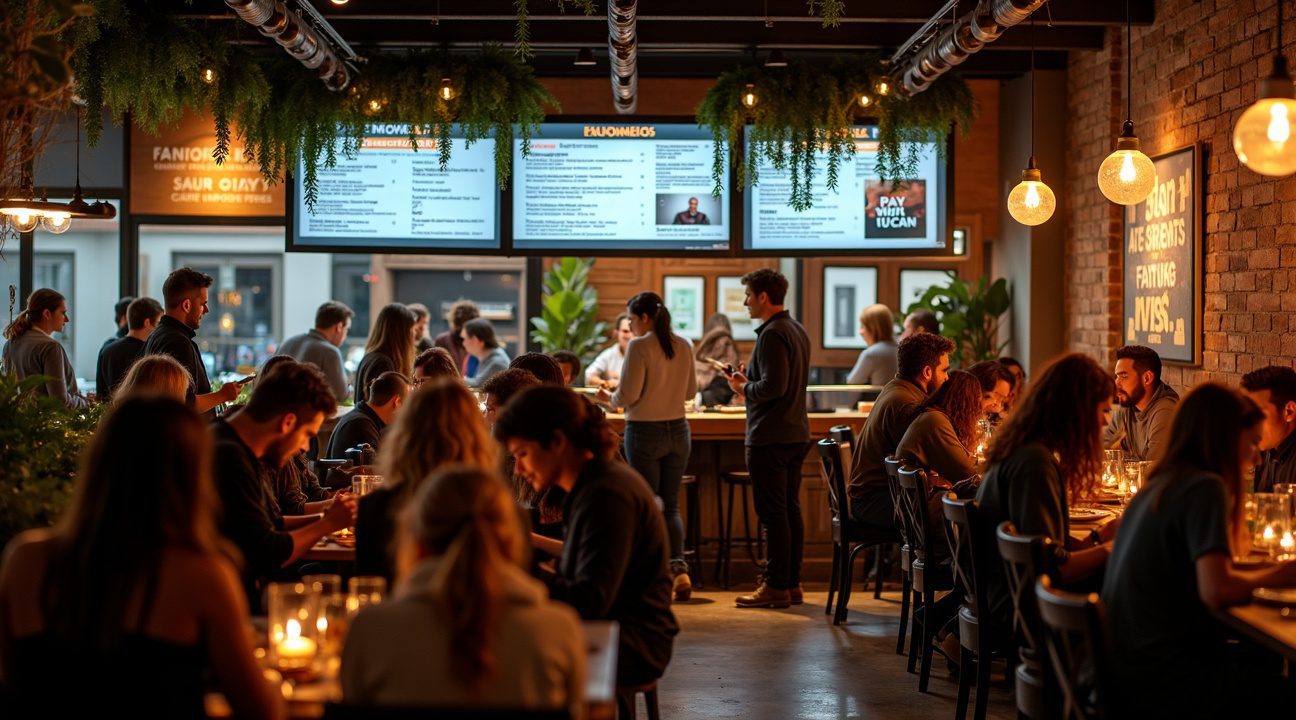
Real-World Challenges and Success Factors for Trust-Based Dining
The pay-what-you-can restaurant model faces unique operational hurdles that traditional establishments don’t encounter. Managing costs becomes exponentially more difficult when revenue streams remain unpredictable from day to day. I’ve observed that successful trust-based dining establishments must develop sophisticated financial planning strategies that account for significant revenue fluctuations while maintaining consistent food quality and service standards.
Building a loyal customer base forms the cornerstone of any viable pay-what-you-can operation. Customers who understand and embrace the restaurant’s social mission often become regular supporters, sometimes paying above market value to help sustain the business. These passionate advocates frequently bring friends and family members, creating a ripple effect that expands the customer community organically.
Essential Elements for Sustainable Operations
- Transparent communication about the restaurant’s purpose and financial needs creates customer awareness and emotional investment
- Strategic location selection in areas with diverse income levels maximizes both paying customers and those in need
- Strong community partnerships with local organizations, churches, and social services expand reach and credibility
- Flexible menu options that can adapt to ingredient availability and cost fluctuations
- Staff training focused on creating welcoming environments for customers regardless of payment ability
- Regular community events and educational programs that reinforce the restaurant’s mission
Location and target demographics significantly influence success rates for these establishments. Restaurants positioned in mixed-income neighborhoods often perform better than those in exclusively affluent or low-income areas. The demographic balance allows paying customers to support those who can’t afford full payments while maintaining overall financial stability.
Alternative revenue strategies become necessary supplements to voluntary customer payments. Many successful pay-what-you-can restaurants develop catering services, private event hosting, or retail product sales to generate more predictable income streams. Some partner with corporations for team-building events or host fundraising dinners where guests pay premium prices to support the mission.
Community engagement extends beyond simply serving meals to people who need them. Successful establishments actively participate in local events, collaborate with food banks, and maintain relationships with social service organizations. This involvement creates multiple touchpoints for community members to understand and support the restaurant’s purpose, much like how Netflix decides to expand its reach through strategic partnerships.
The balancing act between operational sustainability and social impact goals requires constant attention and adjustment. Restaurant owners must monitor daily revenue patterns, track customer payment behaviors, and adjust operations accordingly. Some establishments implement suggested payment ranges to guide customers while maintaining the voluntary payment structure.
Cost management strategies in trust-based dining differ significantly from traditional restaurant operations. Menu planning must prioritize ingredients that offer maximum nutritional value at reasonable costs. Many successful establishments partner with local farms or food distributors to secure consistent ingredient supplies at reduced prices.
Staff compensation presents another challenge since revenue unpredictability affects payroll stability. Successful operations often develop creative compensation packages that include base wages supplemented by tips from paying customers, revenue sharing when monthly targets are met, or additional benefits like meal allowances and flexible scheduling.
The psychological aspect of trust-based dining also influences success rates. Customers must feel comfortable with the payment structure without experiencing guilt or pressure. Restaurant atmospheres that normalize diverse payment capabilities create environments where both paying and non-paying customers feel equally welcome and respected.
Technology integration can support trust-based operations through digital payment options, customer relationship management systems, and financial tracking tools. Some establishments use apps that allow customers to prepay for future meals or contribute to meal funds for others, creating additional revenue streams while engaging tech-savvy supporters.
Marketing approaches for pay-what-you-can restaurants require sensitivity and strategic messaging. Successful establishments focus on community benefit stories rather than charity narratives, emphasizing how the model strengthens local food security and builds social connections. This positioning attracts customers who view their participation as community investment rather than charitable giving.
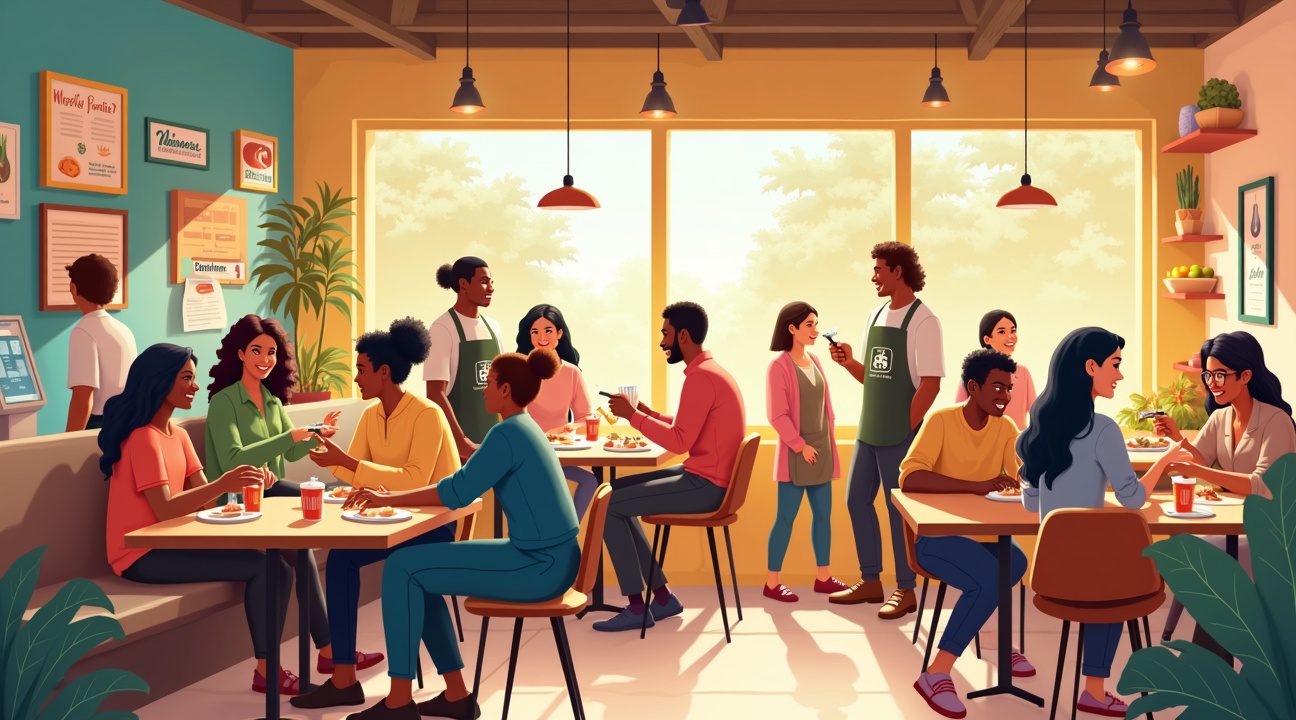
Sources:
BarMetrix – Restaurant Inflation 2025 Trends Data and What To Do
Restroworks – Restaurant Customer Retention Statistics
Square – Square Data Shows How 2025’s Economic Volatility is Impacting the Restaurant Industry
National Restaurant Association – National Statistics
Rezku – Restaurant Industry Statistics You Should Know In 2025
TouchBistro – Restaurant Industry Statistics
Sculpture Hospitality – Restaurant Industry Statistics 2025
MenuTiger – Restaurant Industry Statistics for 2025

